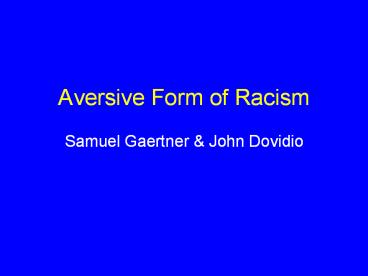Aversive Form of Racism - PowerPoint PPT Presentation
Title:
Aversive Form of Racism
Description:
Aversive Form of Racism Samuel Gaertner & John Dovidio Historical Change White attitudes less racist, more tolerant Subtle, indirect prejudice continues Racist ... – PowerPoint PPT presentation
Number of Views:309
Avg rating:3.0/5.0
Title: Aversive Form of Racism
1
Aversive Form of Racism
- Samuel Gaertner John Dovidio
2
Historical Change
- White attitudes less racist, more tolerant
- Subtle, indirect prejudice continues
- Racist feelings and beliefs among white
Americans are generally the rule rather than the
exception.
3
Aversive Racists
- Sympathize with victims of past injustice
- Support policies for promoting equality
- Still possess negative feelings beliefs
- Cognitive basis in info processing (blacks assoc.
with poverty, crime, welfare) - Not hostility or hatred, but discomfort,
uneasiness, disgust, and sometimes fear. - Unable to recognize institutional racism
4
Question
- Gaertner Dovidio cite Kovel on aversive
racism - But is this aversive racism or how attitudes
work in conditions of metaracism?
5
Studiespro-social behavior
- Wrong-number phone calls
- Anagram task
- Cognitive ability task
- Bystander helping
- Adjective association
6
Wrong-number calls
Black vs. White callers asked S-s to call car
garage
Black White
Conservatives help 65 92
Liberals help (n.s.) 75 85
Conservatives hang up 8 5
Liberals hang up 19 3
7
Interpretation
- Conservatives blatant prejudice
- Liberals
- where norms strong (after hearing request), no
prejudice - Before norms come into effect, prejudice
8
Anagram Helping Task
White vs. black student confederates ask S-s
for help
- Design 2 x 2 x 2 factorial -- white S-s
- White vs. black student confederates
- Internal cause (failure to work hard) vs.
external cause (difficulty of task) - First party request vs. 3rd party request
- Dependent Variable White S-s help or dont help
confederate
9
Anagram Helping Task
- Results
- External cause equal helping
- 3rd party request equal helping
- Internal cause
- self-request 73 whites helped
- 33 blacks helped
10
Interpretation
- Where norms for helping salient --external cause
bystander request -- helping not discriminatory - Where norms for helping not salient --internal
cause, self-request -- helping is discriminatory.
11
Cognitive Task Help-Seeking
Black / white partners offer help S-s may ask
for help.
- Design 2 x 2 white S-s
- Black vs. white partners (confederates)
- Help offered vs. help sought
- Results
- Offered 80 S-s accepted from black
- 55 S-s accepted from white
- Solicited 40 S-s asked help from black
- 60 S-s asked help from white
12
Interpretation
- When black asks for help, both hi-prejudice
low-prejudice subjects help - When norms for helping strong, helping not
discriminatory - Note Interaction Effect S helps black more
than white when asked, S asks whites more than
blacks for help
13
Status and Helping
- Were skipping this experiment!
14
Bystander Helping
White bystanders may help white or black victim.
- Background
- Darley Latane paradigm
- More bystanders less help
- Design 2 x 2 White S-s
- Chairs fall on confed during ESP exp
- White vs. Black victims
- Subject alone vs. with other bystanders
15
Bystander Helping Results
- Victim alone
- S-s help 94 of blacks vs. 81 of whites (n.s.)
- Victim with bystanders
- S-s help 38 of blacks vs. 75 of whites
16
Jury Simulartion Experiment
- Were skipping this one,too!
17
Adjective Association Task
White students try to recognize words.
- Task decide whether string of letters is a word
- Measure reaction time
- Design 2 x 2 White S-s
- Positive vs. negative adjectives
- Paired with whites or blacks
18
Adjective Assoc. Task Results
- Negative adjectives
- No differences paired w/ whites or blacks
- Positive adjectives
- Faster reactions when paired w/ whites than
blacks - No difs between hi- low-prejudice S-s
- Whites associate positive traits with whites
19
Association Priming Study
- Were skipping this one too!
20
Conclusions
- Helping behavior
- Where norms for helping clear strong, whites do
not discriminate - Where norms ambiguous or weak, whites do
discriminate
21
Conclusions
- Associations
- Blacks not evaluated as more lazy, stupid, or
dirty - Whites evaluated as more ambitious, smart and
clean
22
Conclusions
- In most studies, high-prejudice whites and
low-prejudice whites dont differ much in their
behavior.
23
Conclusions
- Prejudiced thinking and discrimination still
exist, but the contemporary forms are more
subtle, more indirect, and less overtly
negative - The contemporary form of prejudice is
expressed in ways that protect and perpetuate a
nonprejudiced, non-discriminating self-image.
24
Conclusions
- Attempts to educate people to accept
egalitarian ideals would have little impact on
aversive racists - Like a virus that mutates into new forms,
old-fashioned prejudice seems to have evolved
into a new type that is, at least temporarily,
resistant to traditional attitude-change
remedies
25
Questions
- Interpretation
- Is salience strength of norms a crucial
factor? - Concept of aversive racism
- Prejudice but conforms to P.C. norms?
- Anti-prejudice but succumbs to stereotypes































